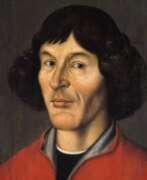Interpreters 16th century


Nicolaus Copernicus (Polish: Mikołaj Kopernik) was a Polish and German scientist, astronomer, mathematician, mechanic, economist, and Renaissance canonist. He was the author of the heliocentric system of the world, which initiated the first scientific revolution.
Copernicus studied the humanities, including astronomy and astrology, at the University of Krakow and at the University of Bologna in Italy. Together with other astronomers, including Domenico Maria de Novara (1454-1504), he was engaged in observing the stars and planets, recording their movements and eclipses. At the time, medicine was closely related to astrology, as the stars were believed to influence the human body, and Copernicus also studied medicine at the University of Padua between 1501 and 1503.
Nicolaus Copernicus, based on his knowledge and observations, was the first to suggest that the Earth is a planet that not only revolves around the sun every year, but also rotates once a day on its axis. This was in the early 16th century when people believed the Earth to be the center of the universe. The scientist also suggested that the Earth's rotation explained the rising and setting of the Sun, the movement of the stars, and that the cycle of the seasons was caused by the Earth's rotation around itself. Finally, he correctly concluded that the Earth's motion in space causes the planets to move backwards across the night sky, the so-called retrograde direction.
Although Copernicus' model was not completely correct, it laid a solid foundation for future scientists, such as Galileo, who developed and improved mankind's understanding of the motion of celestial bodies. Copernicus completed the first manuscript of his book De Revolutionibus Orbium Coelestium (On the Rotation of the Celestial Spheres) in 1532. In it, the astronomer outlined his model of the solar system and the paths of the planets. However, he published the book only in 1543, just two months before his death, and dedicated it to Pope Paul III. Perhaps for this reason, and also because the subject matter was too difficult to understand, but the church did not finally ban the book until 1616.


Sebastian Münster was a German Renaissance scholar, cartographer and cosmographer, historian and linguist-translator.
Münster studied at the University of Tübingen and later taught at the Universities of Basel and Heidelberg. He published several editions of Hebrew grammars and translations from that language, and was the first German to produce an edition of the Hebrew Bible.
In 1544 Münster published his Cosmographia, which was the earliest description of the history, geography, and organization of the world in German. This book was a great success, translated into many European languages and reprinted more than twenty times. "Cosmographia" contained many illustrations and geographical maps of the continents of the world, created by the best engravers of the time.
Among his other works were the "Trilingual Dictionary" (1530) in Latin, Greek, and Hebrew and the "Map of Europe" (1536).


Paolo Ricci (Italian: Paolo Ricci, Latin: Paulus Ricius, German: Paul Ritz), also known as Ritz, Riccio, or Paulus Israelita, was a humanist convert from Judaism, a writer-theologian, Kabbalist, and physician.
After his baptism in 1505 he published his first work, Sol Federis, in which he affirmed his new faith and sought through Kabbalah to refute modern Judaism. In 1506 he moved to Pavia, Italy, where he became a lecturer in philosophy and medicine at the university and met Erasmus of Rotterdam. Ricci was also a learned astrologer, a professor of Hebrew, philosophy, theology, and Kabbalah, a profound connoisseur and translator of sacred texts into Latin and Hebrew, and the author of philosophical and theological works.
Paolo Ricci was a very prolific writer. His Latin translations, especially the translation of the Kabalistic work Shaare Orach, formed the basis of the Christian Kabbalah of the early 16th century.


John Skelton was an English poet and writer of the Tudor period.
He was educated at the University of Cambridge, followed by degrees in rhetoric at Oxford, in the Netherlands, and at Cambridge. He was also a translator of ancient Greek and Roman authors. In 1488 Skelton was appointed court poet to Henry VII and then tutor to the Duke of York (later Henry VIII). In 1498 he took holy orders.
Skelton was known as a poet and satirist on both political and religious subjects. His best-known works include the moralizing play Magnyficence (1516), the humorous poem The Tunning of Elinor Rumming (1520), and numerous satirical poems in which he ridiculed both secular and ecclesiastical authorities. His reputation was confirmed by Erasmus of Rotterdam himself, who spoke highly flatteringly of Skelton.


Immanuel Tremellius or Giovanni Emmanuele Tremellio was an Italian reformer, Hebraist, translator, and professor of Hebrew.
Born in Ferrara to a Jewish family, Tremellius was educated in Padua and converted to Catholicism in 1540, but converted to Protestantism a year later and had to move from place to place. He taught Hebrew at Srasburg, at Cambridge, and later became professor of Old Testament at Heidelberg, Germany (1561). He eventually found refuge at Sedan College, where he died.
Immanuel Tremellius' main literary work was a Latin translation of the Bible from Hebrew and Syriac. He also translated Calvin's Catechism into Hebrew and Greek (1551) and published Bucer's Commentary on Ephesians, based on lectures he had heard at Cambridge (1562), as well as an Aramaic and Syriac Grammar (1569).





















